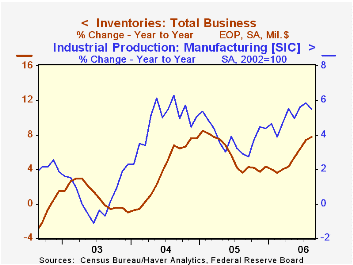 Global| Oct 13 2006
Global| Oct 13 2006U.S. Business Inventory Accumulation Highest Since 2005
by:Tom Moeller
|in:Economy in Brief
Summary
Total business inventories rose 0.6% in August following an upwardly revised 0.7% July gain. Consensus expectations had been for a 0.5% increase. The gain lifted the y/y rate of business inventory accumulation to its highest (7.7%) [...]

Total business inventories rose 0.6% in August following an upwardly revised 0.7% July gain. Consensus expectations had been for a 0.5% increase. The gain lifted the y/y rate of business inventory accumulation to its highest (7.7%) since early 2005.
During the last ten years there has been a 57% correlation between the y/y change in business inventories and the change in factory sector industrial production. Using quarterly figures, there has been an 84% correlation between the change in real private nonfarm inventories and production.
Business sales rose 0.8% (8.1% y/y) on the strength of higher wholesale sales (12.5% y/y) and higher factory shipments (6.1% y/y). The inventory to sales ratio was stable for the third month at 1.26, but was above the May low of 1.25.

Retail inventories rose 0.5% and that's the same rate of increase excluding autos (4.4% y/y) which rose 0.5% (14.1% y/y). Higher building materials inventories led the rise with a 1.0% (9.4% y/y) gain. General merchandise inventories grew 0.7% (0.7% y/y) and clothing store inventories rose 0.4% (5.8 y/y). Furniture inventories fell 0.3% (+4.4% y/y).
Wholesale inventories surged another 1.1% (9.7% y/y) in August though petroleum inventories fell 6.5% (+9.7% y/y). Drug and chemical inventories surged while durables rose 0.9% (10.0% y/y).
Factory inventories rose 0.4%, half the prior month's rate of accumulation.
Understanding How Employment Responds to Productivity Shocks in a Model with Inventories from the Federal Reserve Bank of Richmond can be found here.
| Business Inventories | August | July | Y/Y | 2005 | 2004 | 2003 |
|---|---|---|---|---|---|---|
| Total | 0.6% | 0.7% | 7.7% | 4.4% | 7.6% | -1.0% |
| Retail | 0.5% | 0.4% | 7.5% | 2.7% | 6.7% | 3.8% |
| Retail excl. Autos | 0.5% | 0.3% | 4.4% | 4.5% | 7.1% | 1.9% |
| Wholesale | 1.1% | 0.9% | 9.7% | 7.1% | 9.8% | 1.8% |
| Manufacturing | 0.4% | 0.8% | 6.5% | 4.0% | 6.9% | -7.4% |
Tom Moeller
AuthorMore in Author Profile »Prior to joining Haver Analytics in 2000, Mr. Moeller worked as the Economist at Chancellor Capital Management from 1985 to 1999. There, he developed comprehensive economic forecasts and interpreted economic data for equity and fixed income portfolio managers. Also at Chancellor, Mr. Moeller worked as an equity analyst and was responsible for researching and rating companies in the economically sensitive automobile and housing industries for investment in Chancellor’s equity portfolio. Prior to joining Chancellor, Mr. Moeller was an Economist at Citibank from 1979 to 1984. He also analyzed pricing behavior in the metals industry for the Council on Wage and Price Stability in Washington, D.C. In 1999, Mr. Moeller received the award for most accurate forecast from the Forecasters' Club of New York. From 1990 to 1992 he was President of the New York Association for Business Economists. Mr. Moeller earned an M.B.A. in Finance from Fordham University, where he graduated in 1987. He holds a Bachelor of Arts in Economics from George Washington University.






